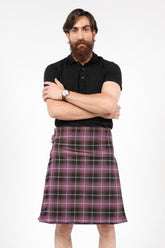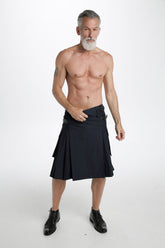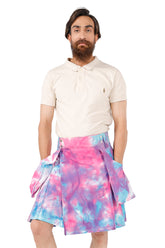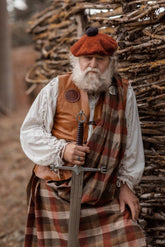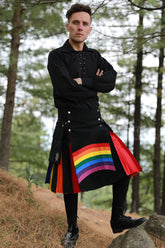What is the Difference Between Scottish & Irish Kilts?
Have you ever wondered about the captivating world of kilts? Kilts are more than just garments; they are expressions of cultural identity and pride. This timeless garment traces its roots to Scotland and Ireland and has a rich history and distinctive characteristics. Let's embark on a journey to explore the enchanting differences between Scottish and Irish kilts, unraveling the threads that weave these cultural icons.
Introduction to Scottish Kilt:
The Scottish kilt, known as Feileadh Mor, is a traditional garment that originated in the sixteenth century for protection against harsh weather. It is widely available and deeply ingrained in Scottish culture, and is associated with clan tartans representing different clans of Scotland. The word kilt is a derivation of the ancient Norse word, kjilt, meaning 'pleated' and it refers to clothing that is tucked up and around the body. Traditionally, the kilt is pleated to the back. The Scottish kilt is typically worn in a tartan pattern, which often stems from the family or clan that the Scotsman is from, and is a way to represent a person's heritage and culture.
What is an Irish Kilt?
An Irish kilt, also known as a tartan, is a knee-length garment with a rich and complex history. Unlike the more widely recognized Scottish kilts, Irish kilts have their own distinct characteristics. They can feature plain colors or county tartans and are often pleated to the side for a unique look. While not as prevalent as Scottish kilts, the Irish Saffron Kilt, a mustard yellow garment adorned with shamrock appliques, gained prominence in the 20th century and is widely worn in Ireland. Contrary to popular belief, the traditional kilt of Ireland is not the Lein-croich, but rather the Saffron Kilt, which holds a significant place in Irish culture.
Shared Heritage between Scottish & Irish Kilts:
Both kilts share a deep cultural heritage, symbolizing pride and tradition. The Scottish kilt, dating back to the 16th century, has a rich history and is associated with tartan patterns. On the other hand, the Irish kilt, such as the Saffron Kilt, has a more complex history and gained popularity during the Gaelic Revival in the late 19th and early 20th centuries. Both kilts are worn with pride to celebrate the shared Celtic heritage of Scotland and Ireland. The Irish Heritage Tartan, for example, was specifically designed to honor this shared cultural heritage. Despite their differences, both kilts serve as a powerful connection to the wearer's cultural roots.
Cultural Significance of Kilts in Scotland & Ireland:
Kilts are an important symbol of Scottish and Irish culture and heritage. The history of kilts in Scotland dates back to the sixteenth century, while kilts have been worn by Gaelic nobility in Ireland for centuries. Today, kilts remain an important symbol of Irish identity and are tied to a person's county or region. The traditional Irish kilt is mustard yellow in color, often with shamrock appliques down the pleat, and is similar in style and appearance to a Scottish kilt. Kilts are worn as a matter of pride and a celebration of Celtic heritage in both Scotland and Ireland. The kilt has come to signify a natural and unmistakable masculinity and is recognized worldwide as a symbol of patriotism and national identity.
What are the Differences Between Scottish & Irish Kilts?
These kilts are both worn as a symbol of pride and a celebration of their Celtic heritage, yet each country's kilt has many differences. Here are some of the key differences between Scottish and Irish kilts:
Tartan Distinctions:
Scottish Kilts
- Scottish kilts often feature family crests or those associated with specific clans, clan kilts reflect the historical links to highland families.
- Represent over 25,000 registered tartans, each unique to a Scottish clan.
Irish Kilts
- Irish kilts typically display only the shamrock crest in their pleats, symbolizing patriotism for the entire country rather than specific clans.
- Irish tartans represent districts and counties, such as the Cork County Tartan.
Kilt Accessories:
Scottish Kilts
- Often worn with clan crests pinned onto their tartans during formal occasions, symbolizing unity.
- Paired with a Prince Charlie jacket
Irish Kilts
- Decorated with shamrock crests and have less prevalence of family crests.
- Paired with a Brian Boru jacket.
Sporrans and Jackets:
- Both kilts pair with formal jackets like Prince Charlie (Scotland) and Brian Baru (Ireland).
- Sporrans, the front pocket of kilts, show similarity; Irish sporrans may feature shamrocks.
Hats and Footwear:
- The Glengarry is the traditional Scottish hat, while Irish wear the Kilkenny; both can be worn formally or casually.
- Knee-high socks with ribbons matching tartan color, along with Ghillie Brogues, are common in both traditions.
While there are many similarities between these kilts, the differences in tartan patterns, cultural significance, and accessories make each kilt unique to its respective country.
Embrace Your Celtic Heritage!
Discover the allure of your Celtic roots with Fashion Kilt – where tradition meets modern style! Embrace Your Celtic Heritage with our impeccably crafted Scottish and Irish kilts. Elevate your fashion game with the authentic designs that pay homage to the rich cultural tapestry of Scotland and Ireland. We offer bespoke kilts that seamlessly blend heritage with contemporary flair. Unleash the warrior within with our Scottish kilts or revel in the spirit of the Emerald Isle with our Irish kilts. At Fashion Kilt, we redefine tradition, making it not just an outfit, but a statement. Embrace your roots!
In conlusion, both kilts are more than just garments; they are expressions of cultural identity and pride. The Scottish kilt, known as Feileadh Mor, originated in the sixteenth century and is deeply ingrained in Scottish culture, associated with clan tartans representing different clans of Scotland. On the other hand, the Irish kilt, also known as a tartan, has its own distinct characteristics, often featuring plain colors or county tartans and is often pleated to the side for a unique look. Both kilts share a deep cultural heritage, symbolizing pride and tradition, and are worn with pride to celebrate the shared Celtic heritage of Scotland and Ireland. While both kilts are worn as a symbol of pride and a celebration of their Celtic heritage, they have differences in tartan distinctions, kilt accessories, sporrans and jackets, as well as hats and footwear, making each kilt unique to its respective country. These differences in tartan patterns, cultural significance, and accessories make each kilt unique to its respective country.
FAQs
What distinguishes a Scottish kilt from an Irish kilt in terms of tartan patterns?
Scottish kilts often feature family crests or those associated with specific clans, with over 25,000 registered tartans unique to Scottish clans. In contrast, Irish kilts typically display the shamrock crest, symbolizing patriotism for the entire country, with tartans representing districts and counties, such as the Cork County Tartan.
How do the accessories for Scottish and Irish kilts differ?
Scottish kilts are often adorned with clan crests pinned onto tartans during formal occasions, symbolizing unity and paired with a Prince Charlie jacket. Irish kilts, on the other hand, feature shamrock crests with less prevalence of family crests and are paired with a Brian Boru jacket.
What are the distinctions in sporrans and jackets between Scottish and Irish kilts?
Both Scottish and Irish kilts pair with formal jackets like Prince Charlie (Scotland) and Brian Boru (Ireland). The sporrans, the front pockets of kilts, show similarities, but Irish sporrans may feature shamrocks.
Are there differences in hats and footwear between Scottish and Irish kilts?
Yes, there are differences. The traditional Scottish hat is the Glengarry, while the Irish wear the Kilkenny. Both can be worn formally or casually. Knee-high socks with ribbons matching tartan color, along with Ghillie Brogues, are common in both traditions.
What makes each kilt unique to its respective country despite similarities?
While both Scottish and Irish kilts symbolize pride and celebrate Celtic heritage, differences in tartan patterns, cultural significance, and accessories make each kilt unique. Scottish kilts often reflect historical links to highland families, while Irish kilts emphasize patriotism for the entire country, and distinct accessories contribute to the uniqueness of each garment.

